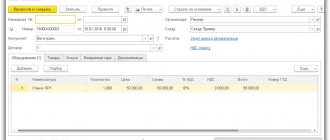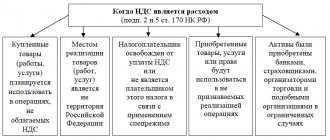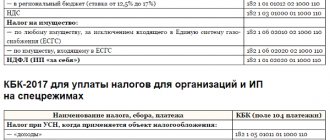Profit is the difference between a business's income and its expenses. If a commercial organization works “in plus”, i.e. makes a profit, she must pay tax. This article will tell you how income tax is calculated, what entries to use and how to avoid typical accounting mistakes.
Income tax calculation: postings
About income tax
“Profitable” tax belongs to the federal group of taxes. It was introduced by the fiscal service to improve control over the activities and revenue of commercial enterprises.
Who pays
Profit tax is required to be paid by:
- Russian commercial organizations;
- foreign commercial organizations that have their representative offices on the territory of the Russian Federation, as well as receiving income from sources located on Russian territory.
The following are exempt from income tax obligations:
- organizations participating in the Skolkovo project;
- taxpayers who own gambling businesses;
- persons applying one of the special regimes for paying taxes;
- persons paying agricultural taxes.
How much to pay
The lion's share of Russian companies deducts 20% of the resulting profit. But there are a number of organizations that apply other rates:
- An income tax of 13% is paid by domestic firms that receive revenue in the form of dividends.
- A rate of 15% is applied to foreign organizations that receive revenue in the form of dividends.
Video - Calculation and payment of corporate income tax
https://youtu.be/0LBohKsbG2g
Based on accounting profit
Accounting profit is not directly related to the taxable base. Income tax is paid to the budget based on tax profit. But in accounting there is an indicator of conditional income tax expense (income), based on which the current income tax can be determined. In this case, the following algorithm of actions is used.
- We determine the conditional income tax expense (let's call it “conditional income tax”, hereinafter – UNP). It is calculated based on accounting profit and tax rate. This amount is reflected in the debit of account 99 “Profits and losses”, subaccount “Conditional income tax expense” and the credit of account 68 “Calculations for taxes and fees”, subaccount “Calculations for income tax”:
Debit 99 subaccount “Conditional income tax expense” Credit 68 subaccount “Calculations for income tax” - conditional income tax is accrued.
| It is important! |
| In the absence of permanent differences, deductible temporary differences and taxable temporary differences that give rise to permanent tax liabilities (assets), deferred tax assets and deferred tax liabilities, current income tax is equal to the deemed income tax expense. |
In the absence of permanent differences, deductible temporary differences and taxable temporary differences that give rise to permanent tax liabilities (assets), deferred tax assets and deferred tax liabilities, current income tax is equal to the deemed income tax expense.
- We determine the current income tax (TNP). To do this, we adjust the amount of the UNT by the amount of permanent tax liabilities (PNO), permanent tax assets (PNA), deferred tax assets (DTA) and deferred tax liabilities (DTL) of the reporting period. This is not difficult to do - you need to take into account the relevant entries that took place during the reporting period:
Debit 99 subaccount “Permanent tax liability” Credit 68 subaccount “Calculations for income tax”
- reflects the permanent tax liability;
Debit 68 subaccount “Calculations for income tax” Credit 99 subaccount “Permanent tax liability”
– a permanent tax asset is reflected;
Debit 09 “Deferred tax assets” Credit 68 subaccount “Calculations for income tax”
– deferred tax assets are reflected;
Debit 68 subaccount “Calculations for income tax” Credit 09
– the amounts of the deferred tax asset have been repaid;
Debit 68 subaccount “Calculations for income tax” Credit 77 “Deferred tax liabilities”
- deferred tax liabilities are reflected;
Debit 77 Credit 68 subaccount “Calculations for income tax”
- reflects the amount of deferred tax liability.
In other words: TNP = UNP + PNO – PNA + ONA – repaid ONA – ONO + repaid ONO
In the absence of permanent differences, deductible temporary differences and taxable temporary differences, which entail the emergence of permanent tax liabilities (assets), deferred tax assets and deferred tax liabilities, the current income tax is equal to the conditional income tax expense (clause 21 of PBU 18/02).
- The resulting amount of current income tax is compared with the amount reflected in the tax return for corporate income tax and is reflected on line 150 of the profit and loss statement.
The organization, following the described method, reflects permanent and temporary differences in the accounting accounts during the reporting period and uses them in the future when determining the current income tax.
Recognition of expenses and income: two legal ways
The law allows businesses to recognize income and expenses in two ways:
- cash;
- accrual.
The first method assumes that the enterprise records the fact of income in its fiscal reports when:
- the cashier accepted the funds;
- there was a transfer to the company's bank account.
Expenses are recognized when payments are made from the cash register, property is disposed of, or money is written off from the company's bank account. This method can only be used by small organizations whose revenue over the last four months does not exceed one million rubles.
Companies using the second method, accrual, record expenses and income when those transactions occur. For example, when purchasing raw materials, tax documents will reflect the date of their transfer to production.
Accounting for PNO and PNA
A permanent tax liability arises if, based on the results for the reporting period, the value of profit in tax accounting is greater than in accounting.
PNO = Prp * NS, where
PNO - permanent tax liability;
Prp - constant difference (positive);
NS is the tax rate, which is equal to 20%.
The accounting entries for income tax in this case will be as follows:
Dt 99 – Kt 68 - accrual of permanent tax liability.
In a situation where profit is less in tax and not in accounting, accordingly, the constant difference turns out to be negative. A permanent tax asset arises.
Income tax is reflected in accounting entries as follows:
Dt 99 – Kt 68 - accrual of conditional tax expense.
The value is equal to the profit in accounting multiplied by the tax rate.
The loss resulting from the operation, which is also multiplied by the tax rate, constitutes conditional income, and is displayed as follows:
Dt 68 – Kt 99.
The calculated profit in tax accounting, multiplied by the tax rate, is the current income tax. There is no need to create correspondence to display it.
As a result of the operations performed, the financial result for income tax becomes equal to the current tax value.
For small businesses, income tax entries look like this: Dt 99 – Kt 68.
You can learn more about tax incentives for income tax in our article “What incentives for corporate income tax are established for 2017-2018?”
Income
Let's consider the features of calculating profitability for different categories of commercial organizations.
Category 1. Domestic companies calculate profit using the following formula:
Profit = Income – Production costs
Production costs are expenses that are directly related to the production of a product or service. Such costs include general production costs, purchase of materials, and labor costs.
Category 2. Companies whose central office is located abroad, but has a permanent representative office in Russia. Profit is calculated a little differently:
Profit = Income – Costs of a representative office of a foreign company in the Russian Federation.
On a note! Organizations that are not included in any of the previous groups are required to deduct tax on all income received in the Russian Federation.
The income that Russian firms receive is divided into two categories:
- Income that a company receives by selling goods or services.
- Income not related to the sale of goods or services (non-sales). This category includes revenue from the sale or purchase of foreign currency; dividends received from third-party legal entities; donated property; interest on loan; penalty for failure to comply with the terms of the contract by a partner or client.
On a note! When calculating tax, do not take into account amounts paid in excise taxes and VAT. If the money was accepted by the enterprise in foreign currency, this amount should be converted into rubles. It is necessary to calculate at the Central Bank exchange rate in effect at the time of revenue recognition.
Which accounting accounts are involved in the postings?
All operations for calculating taxes are displayed on the credit of account 68. To display the accrual of income tax, a special sub-account is opened for it. When calculating profit taking into account the norms of PBU 18/02 (approved by order of the Ministry of Finance dated November 19, 2002 No. 114n), reduction to the general value of the desired value calculated in tax and accounting is observed. In order to link the differences that arise (temporary and permanent) when calculating income tax, various accounting entries are used.
The appearance of these differences is due to the fact that not all expenses in tax accounting reduce taxable profit, but at the same time they are taken into account in accounting. It is for the purpose of subsequent correction of the profit calculated in accounting that it is necessary to take into account all the differences that arise.
Depending on what difference the taxpayer received during the reporting period (deductible or taxable), different entries are applied.
Expenses
When calculating the “profitable” tax, you should take into account only justified and documented costs of the company. Spending by Russian companies is divided into two categories:
- costs associated with the manufacture of products and their sales;
- other expenses (for example, negative exchange rate differences).
There are several types of expenses that are never included in income tax calculations. These include repayment of loans, contributions to the authorized capital, payment of dividends, etc.
Labor costs, material costs, and depreciation are considered direct costs. Each month, firms must include them in the price of finished goods and in the cost of unfinished goods.
In other words, when taxing, this type of expense is taken into account as products are sold, the price of which includes them.
The second group of expenses is indirect expenses. These include renting premises, utilities, communications. In tax reporting, such expenses must appear in the period to which they relate. Indirect costs cannot be directly included in the cost of the final product.
General procedure for calculating (accruing) income tax and advance payments
In general, income tax is calculated as follows.
For transactions taxed at the basic rate of 20%, income tax payable at the end of the year is calculated as the product of the tax base and the tax rate minus advance payments (clause 1 of Article 286, clause 1 of Article 287 of the Tax Code of the Russian Federation):
If an organization pays quarterly payments and does not pay monthly payments, it deducts only the amount of the 9-month advance payment.
If an organization pays monthly advance payments based on actual profits, it deducts the advance payment for 11 months (clause 1 of Article 287 of the Tax Code of the Russian Federation).
What advance payments of income tax are paid?
During the year, advance payments for income tax are paid (clause 2 of Article 286, clause 1 of Article 287 of the Tax Code of the Russian Federation).
Advance payments are paid in one of three ways (clauses 2, 3 of Article 286 of the Tax Code of the Russian Federation):
quarterly;
monthly for the profit of the previous quarter and quarterly;
monthly based on the actual profit received.
The calculation of advance payments for income tax is similar to the determination of income tax at the end of the year. It is calculated as the product of the tax base and the tax rate minus previous advance payments for this year (clause 1 of Article 286, clause 1 of Article 287 of the Tax Code of the Russian Federation).
Let us explain this by calculating the advance payment based on the results of 9 months. The organization pays monthly advance payments during the reporting period at a basic rate of 20%:
Tax (advance payments) at the basic rate of 20% is calculated in separate amounts for the federal and regional budgets (clause 1 of article 284, clause 1 of article 286 of the Tax Code of the Russian Federation).
See also:
How to calculate quarterly advance payments for income taxes
How to calculate monthly advance payments for income tax based on actual profits
Monthly and quarterly advance payments of income tax paid during the quarter
An example of calculating income tax at the end of the year
The taxable profit of the Alpha organization at the end of the year amounted to 1,500,000 rubles.
The amount of the advance payment calculated based on the results of 9 months amounted to 120,000 rubles:
to the federal budget - 18,000 rubles;
to the regional budget - 102,000 rubles.
Monthly advance payments for the fourth quarter were accrued in the total amount of 60,000 rubles:
to the federal budget - 9,000 rubles;
to the regional budget - 51,000 rubles.
1. The amount of tax calculated at the end of the year for the Alpha organization will be 300,000 rubles. (RUB 1,500,000 x 20%), including:
to the federal budget - 45,000 rubles. (RUB 1,500,000 x 3%);
to the budget of a constituent entity of the Russian Federation - 255,000 rubles. (RUB 1,500,000 x 17%).
2. The total amount of the advance payment for 9 months and monthly payments in the fourth quarter amounted to 180,000 rubles. (RUB 120,000 + RUB 60,000), including:
to the federal budget - 27,000 rubles. (RUB 18,000 + RUB 9,000);
to the budget of a constituent entity of the Russian Federation - 153,000 rubles. (RUB 102,000 + RUB 51,000).
3. The amount of tax that must be transferred to the budget at the end of the year by the Alpha organization will be 120,000 rubles. (RUB 300,000 - RUB 180,000), including:
to the federal budget - 18,000 rubles. (45,000 rubles - 27,000 rubles);
to the budget of a constituent entity of the Russian Federation - 102,000 rubles. (RUB 255,000 - RUB 153,000).
If you pay a trading tax, you can reduce the amount of calculated income tax by the amount of the trading tax paid since the beginning of the year. The tax is reduced in the part that is credited to the budget of the constituent entity of the Russian Federation (clause 10 of Article 286 of the Tax Code of the Russian Federation).
In addition, the amount of calculated income tax, which is subject to credit to the budget of a constituent entity of the Russian Federation, can be reduced by an investment tax deduction, as well as by tax amounts paid outside the Russian Federation (clause 1 of Article 286.1, clause 3 of Article 311 of the Tax Code of the Russian Federation ).
See also: How to reduce income tax on trading fees
If the amount of tax calculated at the end of the tax period is less than the amount of advance payments calculated during the tax period, then you do not pay tax at the end of the tax period (clause 1 of Article 287 of the Tax Code of the Russian Federation).
Advance payments
All foreign and domestic commercial organizations in Russia pay income tax not in one amount, but in parts. Such regular contributions to the country's budget are called advance payments. Find out more about them in our article.
Table 1. Existing types of advances
| Advance type | Payment |
| Quarterly | They pay for commercial institutions whose sales income for one previous year does not exceed fifteen million rubles. |
| Monthly, calculated from real profits | Organizations switch to this tax payment schedule voluntarily. To pay tax monthly, you need to submit an application to the fiscal department. But it is important to make the transition before the reporting year. So, in order to switch to monthly payment from 2018, the application must be submitted before December 31, 2020. |
| Monthly, with additional payment of the balance every three months | This schedule is used by those commercial companies that the state does not give the right to use the first option, and they have not switched to the second on their own. |
On a note! Newly incorporated business companies pay advances every quarter. If, based on the results of three reporting months, the income of the new organization exceeds the limit established by the state, they begin to pay taxes every month. But, if the newly formed company initially chose the second option, it will pay advances monthly regardless of the amount of revenue received.
Deadlines for making advances
Contributions must be made at the end of the reporting period. With a monthly payment schedule, advances must be received by the tax department by the twenty-eighth day of the month following the reporting month. The quarterly schedule assumes that money must be transferred by the twenty-eighth day of the month following the reporting month. For example, the first quarterly payment for 2020 (for January, February and March) must be received by April twenty-eighth, 2018.
Organizations using a combined tax payment method must transfer funds every month before the twenty-eighth day. And the balance for the quarter must be paid before the twenty-eighth day of the month following the previous reporting quarter.
On a note! If the payment deadline falls on a Saturday, Sunday or holiday, the advance must be paid on the first day the tax office is open.
Penalties for late payment
A commercial organization cannot be fined for late payment of advances. But for every day of delay, tax authorities charge a penalty.
Property tax
Property tax is established by the legislation of the constituent entities of the Russian Federation. It is paid either at the end of the calendar year or quarterly in the form of advance payments (if any) to the local budget.
It is better to consider the tax as part of other expenses. Reflected by wiring:
- Debit 91.2 Credit 68 “Property”.
Example:
The organization must transfer an advance payment for property tax for the second quarter in the amount of 27,545 rubles.
Postings for the transfer of property taxes:
| Account Dt | Kt account | Wiring Description | Transaction amount | A document base |
| 91.2 | 68 "Property" | Advance on property tax accrued | 27 545 | Accounting certificate-calculation |
| 68 "Property" | 51 | Advance payment transferred | 27 545 | Ref. Payment order |
January 7th, 2013 admin
How to take taxes into account in accounting? For this purpose, account 68 “Calculations for taxes and fees” is used. This is a passive account designed to summarize information about the company’s settlements with government budgets of all levels. By law, all organizations are required to calculate, declare and remit taxes independently.
Synthetic tax accounting is maintained in account 68 “Calculations for taxes and fees.” Analytical accounting is carried out by types of taxes.
Tax accrual is reflected in the credit of account 68 and corresponds with the accounts according to the following classification, taking into account the method of covering accrued taxes:
1. The amount of tax is included in the cost of products, works, goods, services;
2. The tax amount is included in the total revenue;
3. The tax amount is included in the financial results of the company for the reporting period;
4. The tax amount is calculated from the net profit of the organization.
Payment of tax is reflected in the debit of account 68 and corresponds with the company's cash accounts.
Typical entries for the debit of account 68 “Calculations for taxes and fees” (payment of taxes, settlement of tax debts).
D-t 68 K-t 19 Input VAT on purchased goods is credited D-t 68 K-t 50 Payment of taxes and fees to the budget from the company's cash desk D-t 68 K-t 51 Amounts of taxes and fees are transferred from the organization's current account D- t 68 K-t 66 Repayment of debt to the budget by accruing a loan
Typical entries for the credit of account 68 “Calculations for taxes and fees” (tax accrual).
D-t 20 K-t 68 Accrual of tax at the expense of the cost of production D-t 41 K-t 68 Non-refundable tax associated with the purchase of goods and included in their cost has been accrued D-t 51 K-t 68 Refund of overpaid tax to the budget D-t 70 K-t 68 Personal income tax withheld from the wages of company employees D-t 75 K-t 68 Withheld income tax of the company founders
Postings, examples of tax calculation
In accounting, to reflect the fact of payment of any tax, there is a separate account - 68. Sub-accounts for each individual tax are attached to it - “Personal Income Tax”, “Property Tax”, etc.
The withholding of both the tax itself and advances is reflected as follows: D99 K68. When calculating, the figures are taken from the first section of the income tax return. The amount is calculated on an increasing basis. Those. the indicator will not be calculated from the profit received in each specific month, but by subtracting the amount of tax already paid from the tax on revenue received since the beginning of the year.
Accountants indicate the transfer of income tax to the budget using another entry: D68 K51.
Let's give an example of how to reflect tax payments that occur every three months. OJSC Victoria made a fiscal contribution in the amount of 150,000 rubles for the first quarter, and for six months the amount of the accrued advance amounted to 450,000 rubles. In the third time period - 1,000,000 rubles, and at the end of the year, the amount of advance contributions should be equal to 2,000,000 rubles. These numbers must be entered in the income tax return, line 180. The postings should look like this:
Income tax entries
If there was no profit
It is not uncommon for organizations to operate at a loss. At the same time, the advance payment for the current period is less than for the previous one. The accountant must correctly reflect this situation in the reporting documents.
Example. For the second quarter the advance amounted to 200,000 rubles, and for the third quarter it was less - 150,000 rubles. The wiring should look like this:
Postings when the organization was operating at a loss
NNP accounting
To reflect records on taxes and fees in the Unified Chart of Accounts, a separate accounting account 68 is provided. To detail information on each type of fiscal burden, special sub-accounts are opened for this account. For example, 68.4 - settlements with the budget for non-governmental organizations.
Account 68 is active-passive, that is, it can have both a debit and a credit balance. Moreover, the debit balance at the end of the billing period indicates the presence of an overpayment to the state budget. A credit balance, on the contrary, indicates the presence of debt.
Transactions are reflected by postings:
| Operation | Debit | Credit |
| Income tax accrued (posting) | 99 | 68 |
| Income tax paid (posting) | 68 | 51 |
| The offset of overpayments from previous years is reflected (by decision of the Federal Tax Service) | 68 | 68 |
| Refund of overpayment for NNPO reflected | 51 | 68 |
Do not forget that advances for income tax should be reflected in accounting; the postings will be the same: Dt 99 Kt 68 in the “NNP” subaccount.
IMPORTANT!
NNP is calculated on an accrual basis. This means that when calculating payments for the next reporting period (month, quarter), you should not indicate the entire amount of the advance, but only the difference between the amounts accrued for the current period and the previous one. In other words, the amount of NPT accrual must correspond to the data in Section 1 of the tax return for NPT.
Differences
Indicators in fiscal and accounting reports do not always coincide. Thus, the profit appearing in the tax return is often not equal to the amount of net profit obtained according to the accounting documents. This means that the tax that is payable and the tax according to accounting documents can have completely different values. To make them coincide, the state approved a rule called PBU 18/02.
Not all organizations are required to apply this rule. Credit and government institutions are exempt from it. Also, this rule is not applied by organizations working on simplified financial and accounting statements.
For those who use the rule
Differences between fiscal and accounting revenues can be temporary or permanent. The latter happens if costs or income are indicated in only one accounting - fiscal or accounting. This happens in the following situations:
- Costs or income cannot be included in the calculation of the base from which “profitable” tax is paid, but must be used in preparing financial statements.
- Costs or income appear only during taxation, but these amounts are not included in the accounting reports.
Constant expenses that are recorded only in one account and missed in another are called PNO. And the income due to which differences in the time group are obtained are called PNA.
PNO
The group of permanent non-profits includes, for example, expenses for a corporate event or the cost of property that was received free of charge.
The size of the PNO is calculated as follows:
PNO = amount of costs that are included only in tax reporting * tax rate (20%)
PNO = the amount of costs that are included only in the financial statements * tax rate (20%).
PNA
Permanent tax assets include, for example, state duty that was paid for real estate that was not acquired for subsequent resale.
This indicator can be calculated using the formulas:
PNA = the amount of costs that appear only in fiscal reporting * 20% (tax rate)
PNO = the amount of costs that appear only in accounting documents * 20%.
Permanent differences: postings and reporting
BUT of the permanent group is recorded in the debit account 99. In this case, the figure 68 is entered for the loan.
Constant BUTs must be written in reverse: the debit to the account is 68, and the credit to the account is 99.
On a note! Permanent differences in accounting are entered strictly in the month of their occurrence. Therefore, they should not be included in the balance sheet.
Let's give an example. OJSC “Snegovik” accepted free financial assistance in the amount of 200,000 rubles.
The accountant should reflect this transaction as follows:
D 51 K 9-1-1 200,000 rubles.
Money accepted free of charge is recognized among other income of the joint-stock company.
This operation is reflected in accounting documents, but does not need to be included in tax reporting. Since money received free of charge is not subject to taxation. Therefore it is necessary to do the wiring:
D 68 K 99 PNA 40,000 rubles (200,000 * 20%)
If the company operates at a loss
Profitability is not the only result of the company's activities during the reporting period. Quite often, businesses operate at a loss. That is, in the reporting period, the expenses of an economic entity exceed the amount of income received.
In this case, the advance paid by the company for the previous reporting quarter or month may exceed the amount of accrued income tax for the current period. Therefore, it is necessary to adjust the accounting data. Let's look at a specific example of how to reflect this in accounting.
VESNA LLC accrued an advance for the 1st quarter of 2020 in the amount of 250,000 rubles. At the end of the 1st half of the year, the amount of payment under the NNP amounted to 200,000 rubles. We correct the data with the following accounting entries:
| Operation | Debit | Credit | Sum |
| Advance accrued for NNP for the 1st quarter of 2020. | 99 | 68 | 250 000,00 |
| Payment of advance payment to the budget is reflected | 68 | 51 | 250 000,00 |
| The advance amount for the 1st half of 2020 has been adjusted. | STORNO 99 | STORNO 68 | 50 000,00 (200 000 – 250 000) |
Let us remind you how to determine the financial result of an enterprise. Loss or profit before tax (posting) is determined as the difference between the amount of turnover in the debit and credit of account 99 in correspondence with accounts 90 (sub-account “Profit/loss from sales”) and 91 (sub-account “Balance of other income and expenses”). If a credit balance accumulates during the reporting period, this indicates that the company has made a profit. The debit balance at the end of the period indicates the losses incurred.
Temporary differences
This type of difference occurs when costs or revenues are recorded in fiscal and accounting reports at different time periods. They can be deductible or taxable.
The first category includes amounts that reduce the amount of tax in one or more upcoming periods. Taxable BP, on the contrary, makes this amount larger.
If income is recorded in accounting documents before fiscal ones, it is considered that income tax is deferred. In this case, the term IT is used.
Also, deferment of tax obligations occurs when costs are indicated in reports for tax authorities before in accounting reports.
To calculate the value of IT, you need to multiply the difference between fiscal and accounting net profit by twenty percent (the “profitable” tax rate). If we are talking about income, the difference between accounting and fiscal net profit is taken into account, which must be multiplied by the current tax rate.
As expenses (income) are paid off, IT will become less and less.
IT must be recorded in account 77, which is called “Deferred tax liabilities”.
IT is the amount of deferred tax, which in future reporting will entail a reduction in “profitable” tax. To find out what it is equal to, you need to multiply the amount of the temporary difference and the tax rate (currently 20%).
This part of the deferred “profitable” tax appears in accounting in account O9.
We take the tax return as a basis
From January 1, 2008, the current income tax can be determined on the basis of the tax return for corporate income tax (clause 22 of PBU 18/02). With this method, the basis is the tax calculated according to tax accounting data, that is, in exact accordance with the data of the tax return. It is reflected in accounting as the debit of account 99, subaccount “Conditional income tax expense” and the credit of account 68, subaccount “Calculations for income taxes.” That is, the current income tax in the accounting accounts is determined by this single entry. Then the question arises: how to form permanent, deferred tax liabilities (assets) in accounting and how to apply the mandatory PBU 18/02? The answer is provided by paragraph 3 of PBU 18/02, which establishes that information on permanent and temporary differences can be generated on the basis of primary accounting documents in the accounting accounts or in another manner determined by the organization independently. That is, in the case of determining the current income tax on the basis of a tax return, it is necessary to consolidate this method in the accounting policy and create permanent and temporary differences not in accounting accounts, but in primary documents, including independently developed ones. Accordingly, the correspondence debit to account 99, subaccount “Conditional income tax expense” and credit to account 68, subaccount “Calculations for income tax” will become the only entry in accounting and reflect the income tax according to the tax return. And the indicators in the financial statements will be formed without the use of permanent and temporary differences.
| It is important! |
| Information about permanent and temporary differences can be generated on the basis of primary accounting documents in the accounting accounts or in another manner determined by the organization independently. |
For small businesses and non-profit organizations that are exempt from the obligation to apply PBU 18/02, but are required to fill out the “current income tax” line, there is no need to conduct additional calculations of permanent and temporary differences. But we repeat once again: if the named organizations are payers of income tax, they are required to fill out line 150 of the profit and loss report (clause 2 of PBU 18/02). As you can see, the second way to determine the current income tax is, at first glance, much simpler. Organizations required to apply PBU 18/02 simply need to keep records and reflect permanent and temporary differences (clauses 3, 7, 14, 15 PBU 18/02) in the manner prescribed by the accounting policy, that is, in those developed independently and approved by the accounting policy primary accounting documents. It must be said that many accountants prefer not to use this opportunity, believing that by not reflecting permanent and temporary differences directly on the accounting accounts, the organization violates the requirement of mandatory application of PBU 18/02. We hope that this article will help re-evaluate this belief. Yu. Pimenova, expert editor Material provided by the magazine “Practical Accounting
”
Stay up to date with the latest changes in accounting and taxation! Subscribe to Our news in Yandex Zen!
Subscribe
Common mistakes when calculating taxes
In order not to incur claims from tax authorities during an audit, you need to correctly take into account income and expenses, calculate profits and charge taxes. Here are some of the most common taxpayer mistakes:
- Debt on loans that have already expired is counted as income. The accountant must recognize the debt as income in the period in which the claim period expired. In tax accounting, an overdue creditor is also considered income. If there is a delay, the responsible person is obliged to write an accounting statement, add this amount to income, and calculate income tax from it.
- If an organization receives income from loans issued to other persons , it does not matter when exactly the interest was actually received and what terms are specified in the agreement. The accountant must calculate income tax in each reporting period (month, quarter) evenly.
- In orders for issuing bonuses, it is better not to indicate that the money is not given for labor merit. If a company plans to give bonuses to employees due to holidays, you need to find a good reason for this. Bonuses should be linked to employee performance achievements. Also, the possibility and procedure for paying bonuses must be specified in individual or collective labor contracts. Only under such conditions can bonuses be legally considered expenses.
- If you plan to pay employees going on vacation additional financial assistance , in all acts call it a regular additional payment to vacation pay. These amounts can be included in staff wage costs if several conditions are met. Firstly, additional payments to vacation pay must be specified in employment contracts (individual, collective). Secondly, the amount of payments directly depends on the employee’s compliance with the organization’s requirements and the employee’s salary. The amount of additional payment can be directly proportional to the salary, reduced in case of violations of discipline, etc.
Postings to the debit of account 68 when generating income tax
You can understand which income tax account should be used when applying PBU 18/02 using the following algorithm. The tax in this case is formed as follows:
- The tax calculated from accounting profit is documented by posting Dt 99 Kt 68.04.2.
- Tax amounts (permanent tax liabilities) accrued from the permanent difference are taken into account:
- Dt 68.04.2 Kt 99 – from income not taken into account for tax purposes;
- Dt 99 Kt 68.04.2 – from expenses not taken into account for tax purposes.
3. Tax amounts accrued from temporary differences at the time of their occurrence in accounting are taken into account:
- Dt 09 Kt 68.04.2 – deferred tax assets (for expenses accepted in accounting earlier than in tax accounting);
- Dt 68.04.2 Kt 77 – deferred tax liabilities (for expenses accepted in tax accounting earlier than in accounting).
4.Tax amounts are taken into account for previously accrued temporary openings for which it became possible to close in a given period. Which account - deferred tax assets or deferred tax liabilities - is closed depends on the type of temporary difference:
- Dt 68.04.2 Kt 09 – deferred tax assets (for expenses accepted in accounting earlier than in tax accounting);
- Dt 77 Kt 68.04.2 – deferred tax liabilities (for expenses accepted in tax accounting earlier than in accounting).










